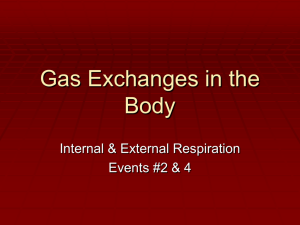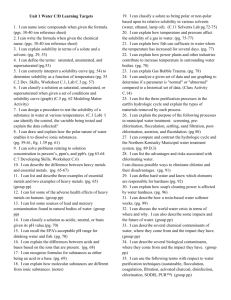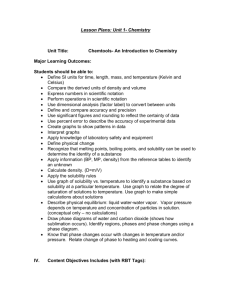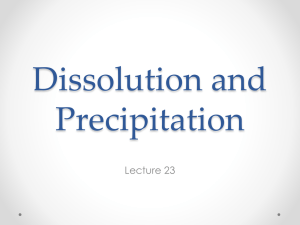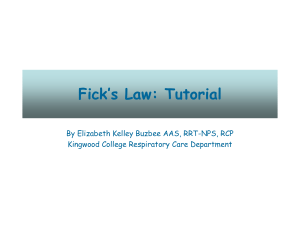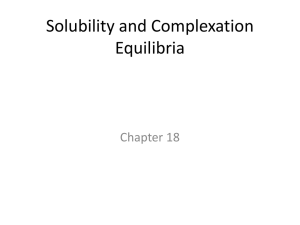respiratory system part iii
advertisement
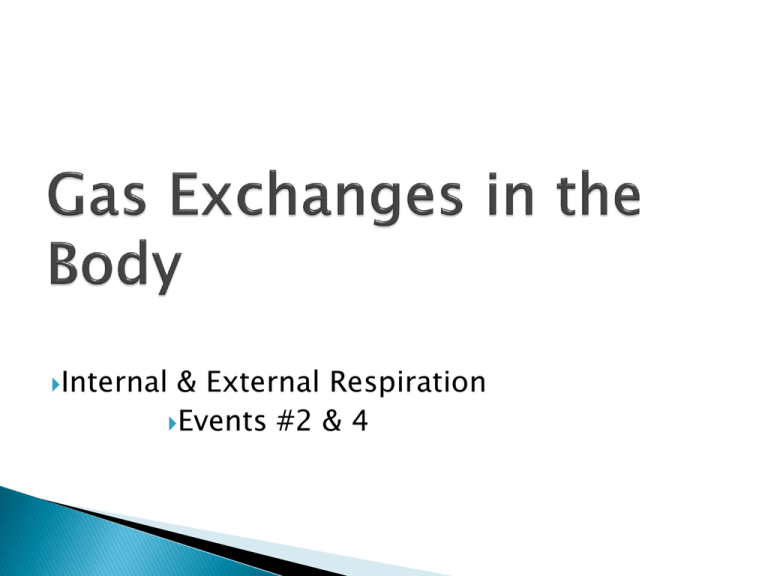
Internal & External Respiration Events #2 & 4 Used to determine the individual pressures of each gas in a mixture of gases Based on % of total of 760 mmHg of total atmospheric pressure Gas exchanges that occur: Between the blood and the alveoli AND Between the blood and the tissue cells Take place by simple diffusion Depends on partial pressures of oxygen & carbon dioxide that exist on opposite sides of the exchange membrane (Dalton’s law of partial pressures) Always flowing from high to low states that the solubility of a gas in a liquid is directly proportional to the pressure of that gas above the surface of the solution (IOW: the higher the pressure of the gas, the more gas will be shoved into the liquid thus increasing solubility) Solubility (of a gas) and partial pressure have a direct relationship The solubility coefficient of the gas also affects this process – the higher the #, the more the gas “likes” to dissolve into a liquid (based on molecular structure, etc.) Each gas will dissolve in a liquid in proportion to the ratio between its partial pressure gradient and its solubility coefficient CO2 = .57 O2 = .024 N2 = .012 Solubility & temperature have an inverse relationship. Increase in temperature causes increase in kinetic energy causes more molecular motion which allows molecules to break the intermolecular bonds and escape from solution And vice versa Partial pressure gradients and gas solubilities Oxygen = has low solubility but steep partial pressure gradient (105 mmHg in alveoli – 40 mmHg in blood = 65 mmHg pressure gradient) Carbon dioxide = has solubility ~20x greater than oxygen but partial pressure gradient is only 5 mmHg Partial pressure gradients and gas solubilities Due to the ratios of solubility coefficients and pressure gradients: ~Equal amounts of gases are exchanged Thickness of respiratory membranes 0.5 to 1.0 micrometers edematous (swollen) tissue can be caused by congestion and pneumonia - hinders diffusion leading to hypoxia oxygen deprivation Surface Area 50-70 square meters for gas exchange Emphysema or cancer Walls of alveoli break down Less surface area for gas exchange The phrenic & intercostal nerves transmit impulses to the respiratory muscles Irritation to phrenic nerve is responsible for hiccups (spasm of diaphragm muscle) Neural centers are located in medulla & pons Eupnea = normal respiration rate Approx 12-15 breaths per min Hyperpnea = higher than normal rate Apnea = No rate Dyspnea = general term for abnormal rate Physical factors, conscious control, emotional factors, and chemical factors all influence rate & depth of breathing. Deep & rapid respiration, too much CO2 is vented out of the body so: Not enough acid production H2O + CO2 = H2CO3 (carbonic acid) Respiratory alkalosis results Treatment: trap the CO2 and rebreathe it till breathing returns to normal Slow & shallow respiration with not adequate expiration so CO2 is not vented out of the body Production of excess acid H2O + CO2 = H2CO3 (carbonic acid) Respiratory acidosis results Usually caused by disease process: COPD Asthma Obesity Trauma Pneumonia Symptoms: inflammation of mucosa – chronic mucus production Normal Bronchitis Breathing is very labored due to lack of alveolar recoil End stage: Alveolar walls collapse = loss of surface area so less gas diffusion Membranes thicken so decrease in diffusion eventually Both emphysema and chronic bronchitis have: Smoking history Dyspnea = air hunger due to dysfunctional breathing Coughing & pulmonary infections Will develop respiratory failure, hypoxia, acidosis Basic Info 1/3 of all cancer deaths are due to lung cancers 90% have a smoking history Metastasizes VERY rapidly due to vascularity of lungs Begins in larger bronchi & bronchioles Forms masses that have bleeding cavities within them Nodules that develop in peripheral areas of lung Develop from alveolar cells & bronchial glands Originate in primary bronchi Grow into small grape like clusters in mediastinum Very aggressive cancer Resection of diseased portion of lung (thoracotomy) Radiation therapy Chemotherapy • • • • Genetic disorder – recessive Causes oversecretion of thick mucus that clogs respiratory passages Impairs food digestion by clogging ducts that secrete enzymes Multiple other organs are affected • • • • Sudden, unexplained death of an infant less than 1 year old Possibly caused by brain abnormalities that control respiration, heart rate, or consciousness Environmental factors to reduce risks – sleep on back not on stomach, firm crib with no blankets or stuffed animals or pillows Sudden infant death syndrome (SIDS): Risk factors - MayoClinic.com • • • Chronically inflamed hypersensitive bronchial passageways Bronchoconstriction of passageways in response to allergen, temperature changes, & exercise Can be managed with medication Hyperbaric oxygen chambers – designed to force greater amounts of oxygen into patient’s blood Treats tissues affected by poor circulation Patient breathes in regular air while body is under pressure Increased pressure means increased solubility of gases (incl oxygen) More oxygen in blood benefits treatment of certain conditions Tetanus Gangrene Migraines Slow healing wounds Burns/skin grafts Stroke Autism Traumatic Brain Injury Decompression Sickness Cerebral Palsy Multiple Sclerosis Fibromyalgia Many other conditions • • The Physics of Diving - Scuba Gas Laws As you go down in depth, the water puts pressure on your body Increased pressure = increased solubility of inhaled gases into the blood • • • • As you come up at the correct rate, the pressure decreases slowly So the solubility decreases slowly So the gases come out of the blood And you can exhale them • • • • If you come up too rapidly, the pressure decreases rapidly So the solubility decreases rapidly So the gases come out of the blood too fast to exhale them properly The excess gas bubbles can collect in joint spaces, arteries, tissues, etc. causing coronary, pulmonary, or brain embolisms Auditory or eustachian tubes provide an avenue for equalizing middle ear pressure with atmospheric pressure via the flow of gases Air will either move in or out of your ears to cause this equalization This is the cause of your ears “popping” Notice swollen vocal cords and mucus accumulation Read through the Developmental Aspects section of your notes
